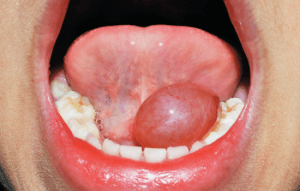 Dentists have an absolutely specific range of terms that denote such a phenomenon as a ball under the tongue.
Dentists have an absolutely specific range of terms that denote such a phenomenon as a ball under the tongue.
This is inflammation on the surface of this organ, or in its interior, but with a mandatory exit to the surface.
Each of the terms implies a globular formation, which is directly related to the language and can appear:
- on the back of the tongue;
- in the sublingual area;
- in the zone bordering the body.
A ball is usually a small-diameter cavity filled with liquid located under a thin layer of mucous membrane. The liquid, as a rule, is transparent( but it can also be colored).And this property becomes more and more noticeable as the size of the tumor grows. Because it grows, sometimes slowly, sometimes very quickly - the rate of growth depends on the mechanism of inflammation.
The phenomenon described can be:
- wound;
- by hematoma;
- by the manifestation of stomatitis;
- by a tumor( benign or malignant);
- is a sign of an infectious lesion of the oral cavity.
But the most common reason for which a ball has appeared under the tongue is the formation of a retention cyst due to damage to one of the small salivary glands of the hyoid area. Less commonly, the source and growth of a pathological bladder or ball under the tongue becomes an injured sublingual salivary gland.
Content of
What is the retention cyst
- What are the causes of the cyst
- What recommends traditional medicine
What is the retention cyst
The retention cyst is spoken in the case wheneducation has:
- submucosal localization;
- elastic consistency;
- is relatively small;
- Serous or serous-sacred contents( clear, yellowish, turbid, or with obvious signs of blood clots);
- is painless for the patient and for the examination.
The retention cyst has a distinctive feature. Quickly emptying( due to the comparative thinness of the wall, easily pierced), it completely restores the previous volume after a short period of time.

This is explained by two factors:
- the gland has a capsule bag that sets the cyst for a specific volume and diameter and does not allow it to decrease;
- duct, which secretes the secretion of the gland to the outside or is completely clogged, or significantly narrowed, so that it can not be emptied naturally.
The color of the cyst depends on the coloration and properties of the contents accumulating inside: 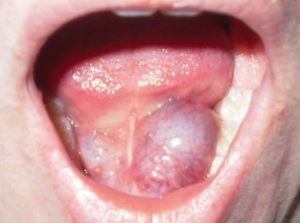
- Transparent .Locked in the cavity of the gland, the slimy-salivary secret creates the effect of a slowly swelling bubble filled with a clear liquid.
- Bloody .If a red ball appeared under the tongue, the result was a trauma with a capillary rupture. The liquid will be supple, bloody, frankly bloody - it will be different shades of red( from bodily to burgundy), or with the inclusion of blood clots-clots.
- Bluish .The shade indicates the stagnation of venous blood in the damaged area.
- Turbid .When suppuration, the contents of the cyst grow dull, yellow, giving it the appropriate color. The same signals the worsening of the general condition of the patient.
For what reasons there is a cyst
There are several. The inflammatory process, which disrupts the mode of operation of the gland, is provoked by the cause:
- thermal;
- mechanical;
- chemical.
If the first variant is caused by a burn( more rarely - by abrupt hypothermia of the mucous membrane), then the second one is damaged by food containing bones and solid inclusions, a toothbrush, toothpick or trauma resulting from biting the mucosa in a given place.
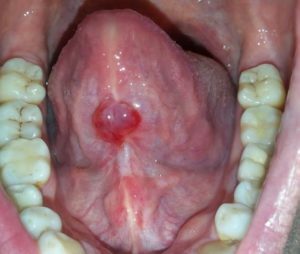 Under the influence of caustic and chemically active substances( acetic essence, coarse salt, spices of great severity and strength and the like), a third mechanism of damage is realized.
Under the influence of caustic and chemically active substances( acetic essence, coarse salt, spices of great severity and strength and the like), a third mechanism of damage is realized.
Retinal sublingual cyst is also called a wounded, mucous cyst, and in common parlance - a "frog tumor" because of the similarity of the shape with the frog's egg.
In a chronically prolonged, relapsing variant of existence( up to several months), it has the appearance of a dense knot with a thickened wall, with a cherry-colored surface and blurred boundaries.
Other causes of balloon-bubble
No growths under the tongue can be ignored, because it can be a symptom of a dangerous infection for the body:
- of syphilis in the secondary stage( Papillosis syphilidae);
- of a true pemphigus - an intractable severe disease( and without treatment - leading to death).
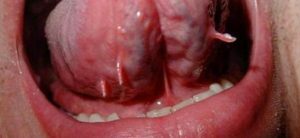 It can also be a malignant tumor of the tongue - cancer. But even benign papilloma and lipoma( manifested by the appearance of appendages under the tongue, as in the photo), characterized by slow growth, painlessness and the specific nature of the surface, must be studied and resolutely removed.
It can also be a malignant tumor of the tongue - cancer. But even benign papilloma and lipoma( manifested by the appearance of appendages under the tongue, as in the photo), characterized by slow growth, painlessness and the specific nature of the surface, must be studied and resolutely removed.
In contrast to the wound, the appearance of a hemorrhage in the tissue - the hematoma, always have a clear connection with the damage to the teeth or otherwise. It is almost always red in color and painful. In case of minor injury, it dissolves itself in a few days. Danger is the suppuration of the hematoma, which requires the intervention of the dentist.
To the appearance of stomatitis can lead:
- damage to the mucous cleft or cariously destroyed tooth, dental calculus;
- the habit of gnawing a pencil, pen, match or other foreign object;
- susceptibility of the organism to acute infections or the presence of a chronic disease, beriberi.
The stomatitis can appear as a small convex rounded white outgrowth( pimple or pimples) under the tongue or on the side of the bridle, which causes pain( itching and burning, worse with eating and talking).The usual color is grayish or dirty white.
Of the dangerous symptoms associated with the appearance of a tumor, the appearance of
- lymphadenitis( submandibular or involving other areas of the neck) should be highlighted;
- trends in the spread of hyperemia and swelling to the entire region and neighboring regions;
- high( moderately high) temperature;
- of growing ailment: headache, sore throat, sweating, nausea, dizziness, frequent palpitations, dyspnea.
Diagnostic measures
An assessment of the severity of the patient's condition, diagnosis of the developed pathology and subsequent treatment is performed by a dentist.
In order to differentiate the state from similar cases it is carried out:
- anamnesis;
- visual inspection of the oral cavity;
- studies of other areas and body systems.

Next, instrumental and laboratory studies are performed:
- contrast sialography;
- identification of pathogens obtained by smear-print, scraping, puncture cyst;
- general clinical studies, including blood tests, urine and other necessary techniques.
Application of radiographic, MRI or ultrasound-based methods allows not only to reveal the extent, volume and structure of education, but also to differentiate the wound under the tongue from:
- dermoid cyst;
- cysts of a different nature;
- hemangiomas;
- lipomas;
- of salivary disease;
- of sialadenitis.
About treatment methods
In the case of a variant in which the neoplasm in the oral cavity does not undergo an independent reverse development, a differentiated approach is necessary.
Most often, measures are taken to remove it. This is done using: 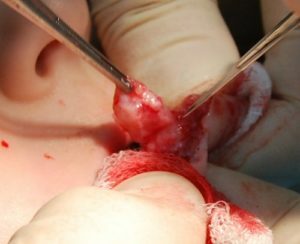
- scalpel or laser;
- cryotherapy method.
In the formation of the salivary gland cyst( or when a stone is formed in it) with an inability to restore the patency of the duct, an operation is performed - cystosialoadectomy( excision of the salivary gland together with its capsule).
Similarly come with benign tumors, cancer treatment is performed after careful preliminary training and in a specialized medical institution.
Therapy of inflammatory or non-inflammatory diseases is performed using the appropriate pharmacological means:
- of the glucocorticoid hormone .Assign prednisolone, Hydrocortisone, Tramcinolone.
- Cytotoxic .Methotrexate.
- Antibacterial drugs .Antibiotics and antiseptics of various classes, taking into account the need to prevent dysbacteriosis. With this task, cope, using eubiotics - drugs containing bifido- and lactobacilli.
In order to increase the body's immune resistance, complexes enriched with vitamins A, C, E and Group B, tissue therapy and methods of physiotherapy are used.
What is recommended by traditional medicine
In terms of local treatment, the use of traditional medicine will be very useful.
In addition to irrigation of the wound surface after the operation with traditional antiseptic solutions( furacilin, hydrogen peroxide, rivanol), it is acceptable to use infusions and herbs of herbs and other natural medicinal raw materials for the same purpose. Efficiently clean the oral cavity of bloody and purulent discharge will allow the compositions of chamomile, calendula, sage.
The use of nettle decoction combines the disinfectant and hemostatic properties, if it is necessary to obtain a tanning effect, a decoction of oak bark prepared on a water bath is used.

The use of propolis and aloe juice gives fast healing of microdamages. For the same purpose, a solution of table salt with the addition of soda and a drop of iodine tincture is often used.
It must be remembered that iodine in any form is accumulated in the thyroid gland. Therefore, before using it, consult a dentist. The same should be done and if you want to use another drug - all drugs can be used only after their approval by the doctor.
We should not also consider that getting rid of such a problem as a cyst and the like is possible only with the use of traditional medicine methods - they are good only as an aid to medicine official and can not replace it.
To the issue of prevention of
Preventing problems with the oral cavity means preventing the development of infectious and inflammatory processes in it, the phenomena of dysbiosis, and tumor diseases.
 Therefore, it is necessary to strictly adhere to the doctor's recommendations for keeping the mouth healthy, timely treatment of problem teeth, and in case of failure - replacement of their adequate orthodontic structures.
Therefore, it is necessary to strictly adhere to the doctor's recommendations for keeping the mouth healthy, timely treatment of problem teeth, and in case of failure - replacement of their adequate orthodontic structures.
In addition to compliance with hygiene standards, attention should be paid to the treatment of chronic diseases of the body, as well as to lead a maximally healthy lifestyle.
Prevention of the appearance of diseases of the mouth is possible, if you follow the recommendations of official medicine and the arguments of common sense. And with their availability, the methods and means of modern dentistry will help to solve the problem as quickly and without excessive material and moral costs.
